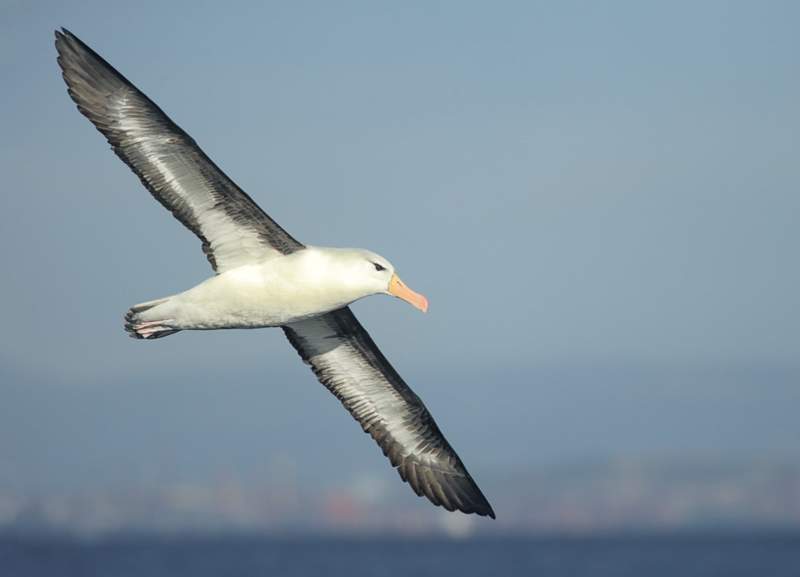Family: The Black-browed Albatross (Thalassarche melanophris) belongs to the Diomedeidae family of albatrosses, which also includes shearwaters, fulmars, storm petrels, and diving petrels.
Habitat: This thick-necked, robust albatross is the most common albatross in southern Australian waters, whether alone or following ships or gathering in flocks of several hundred at flushes of food. These birds usually arrive off the coast of New South Wales several weeks before the Wandering Albatross, and they depart earlier. When close inshore, Black-browed Albatrosses can often be seen clearly from the ground.
In the Northern Hemisphere, the Black-browed Albatross crosses the equator occasionally and hunts for food in vast areas of the ocean, traveling south of the subtropical convergence. It also roams south of the subtropical convergence and circumnavigates seas south of the subtropical convergence. During the day, it eats refuse and carrion thrown out by ships, but at sea, it usually eats squid, crustaceans, and fish. As it lands on the water to feed, it spreads its legs and heads back to skate forward on its feet for several meters before settling and folding its wings.

Identification: There is no difference between the sexes, but the male is slightly larger. The body is white. A slate-black back and upper wings; a white underwing with broad black edges. The tail is grey, appearing black, with conspicuous white feather shafts. White face with a dusky smudge over the eye. Eyes are brown. The bill is flesh yellow with a pale red tip. Toes, feet, and webs are blue-grey to flesh-pink in color.
Unlike the immature Grey-headed Albatross, the immature bird has a lighter grey suffusion on its head and neck, as well as a distinctive grey-brown collar. There is a duller brown color on the upper and underwings. As the bird grows older, the bill turns orange-yellow with a dusky ridge and tip. In the young, the downy is grey-downed with a white mask on the fore face; its bill is black; and its feet are flesh-colored.
Vocalizations: Black-browed Albatross calls are guttural gruntings and cackling calls when squabbling/or feeding. Whistling braying notes when displayed. Chick peeps. The bird is silent in flight. There is a lot of noise in colonies as they try to mark their territory and cackle harshly as well. Their fanned tails are used in courtship displays.

Nest & Breed: Breeding and nesting in colonies between September and late April or early May. A large mud bowl is nested on a steep bank ledge or slope, reinforced with plant matter or feathers. Birds dive for food, plunging down until only the tips of their wings are visible. In September-October, Black-browed Albatrosses nest on their breeding islands.
A ceremonial display of pair-bonding is elaborate. Nest building involves the male collecting mud and bringing it to the female while she stands on the nest. During this process, he bows his head to the ground, spreads his tail, and brays, exposing a stripe of pink skin at the gape. In response, the female bows and brays, and then they nibble each other, bow, and bray again. The birds also nod, touch their bills, quiver them, turn their heads, and nibble on each other’s heads. Young albatrosses protect themselves by vomiting stinky stomach oil when threatened, while adults peck and gape.
Eggs & Incubation: Black-browed Albatrosses lay one egg; dull white, with pink tinges and dark red-brown markings toward the large end; oblong-oval, about 103 x 66 mm. For both sexes, the incubation period is approximately 70-71 days. In four to five months, the young fledged. The eggs are laid in late October and hatch in early January. The parents share the responsibility of brooding the clutch in its first month, feeding it at intervals. Within four to five months, both it and its parents leave the breeding islands.

Distribution: The Black-browed Albatross is found throughout the Southern Hemisphere, south of the subtropical zone. Breeds on sub-antarctic islands such as Heard and Macquarie.
Races: There are 2 races; one widespread with dark brown eyes, the other with pale yellow-brown eyes, and breeding only on islands south of New Zealand. Both races visit Australia.
Diet: The species feeds on fish, squid, crustaceans, carrion, and the waste of fisheries. Food has been observed being stolen from other species by this species.
Life Span: Black-browed Albatross can have a natural lifespan of 70 to 75 years.
Taxonomy: On the basis of a specimen from the Cape of Good Hope, Coenraad Jacob Temminck described the black-browed albatross as Diomedea melanophris in 1828.
Alternative Names: It is also known as Black-browed Mollymawk.
Size & Weight: Black-browed Albatross size is about 880 mm; wingspan 2200 mm and an average weight of 2.9 to 4.7 kg.
Read More – Wandering Albatross – The Largest Flying Bird







